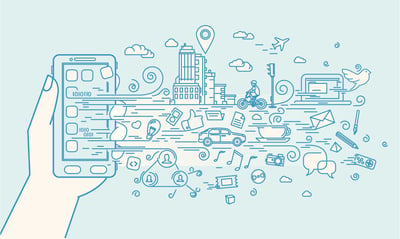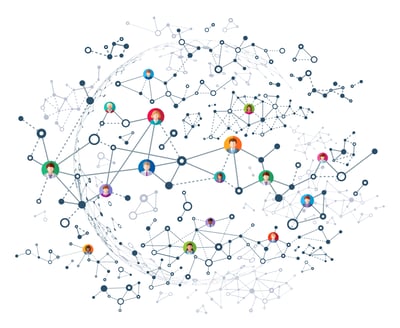February 12, 2024
 by John Croll / February 12, 2024
by John Croll / February 12, 2024

In today's hyper-connected world, public perception is everything.
PR, media, communications, and marketing professionals know their success hinges on monitoring what's being said about their company across both traditional and social media. That's why media monitoring has become mission-critical.
Media and social media monitoring are services that mine, aggregate, search, and analyze data from media sources, public websites, and social media.
These services provide relevant insights to organizations that assist them in better understanding their reputation, competitive market, and the media landscape to make more informed business decisions.
These monitoring services must focus on fast-moving product innovations, agility, usability, and speed to stay competitive and meet the industry's needs.
In this blog, we will learn about the benefits and use cases of media monitoring and how you can use these services in the rapidly changing media landscape, where there is an increasing amount of fragmented data.
Let’s delve into the top five reasons why social media monitoring services are critical.
The media industry is constantly evolving, and an overwhelming amount of information is available from many sources.
In the past, PR and communication experts had the difficult task of sifting through this vast amount of data to identify the most relevant and essential information as quickly as possible.
However, with AI integration into media monitoring and social media monitoring services, we now have effective communication insights, thus maximizing media monitoring strategy.
These services, powered by AI and smart tech, identify all relevant activity (including social content and conversations), conduct sentiment analysis, and provide curated insights that give PR and comms professionals actionable insights, all in near real time.
Source: Truescope
With real-time insights into an organization's brand and industry, PR, comms, and marketing professionals receive vital information about emerging crises first.
This allows them to manage the situation effectively. Media monitoring is crucial for PR analytics to analyze and interpret campaign, media coverage, and social media engagement data.
Social media monitoring provides access to all relevant global public domain information, which is invaluable for media professionals to make informed decisions. This high-level impact and contributions to an organization will increasingly give these professionals an essential place at the C-suite table.
For years, PR teams have relied on social media monitoring to track their organization's image in the public eye, often comparing it to how their competitors are portrayed.
The speed and bandwidth at which media intelligence now processes data means it's possible to monitor competitors in the market and get deep and timely insights about their business environment to their competitive advantage.
This could involve evaluating a company's performance across multiple topics, gauging the sentiment of your coverage compared to competitors, and identifying prominent key phrases, emojis, and hashtags to grasp trending topics in your industry.
It also entails surfacing who is discussing a brand and the nature of those discussions, using social engagement metrics to identify influential authors or media channels shaping industry conversations.
Additionally, it involves analyzing the success of owned content pieces and determining the optimal times to post within your industry, among other aspects.
The capabilities are endless using the finely tuned relevance and analytics features of social media monitoring. With fundamental insights into what an organization’s competitors are doing and how they are being perceived across all media, companies can tailor messaging and content to better resonate with their audience.
Media insights provided by monitoring tools serve PR and communications experts in evaluating their organizational and reputational standing. They aid in brand monitoring, understanding how your CEO is perceived in crucial markets, and identifying pressing issues requiring prompt attention.
With media intelligence, social media monitoring tools can quickly answer questions such as:
Media intelligence incorporates information from news articles, social media interactions, and search queries. You can gain insights into what you should avoid doing in order to prevent and address similar situations.
Advanced media monitoring and social media monitoring tools, such as coverage spike alerts, can also provide a crucial edge to PR and comms pros when anticipating a crisis or looking to enter a conversation at an advantageous point.
Source: Truescope
You need to keep track of media and public discourse issues, as well as analyze performance and trends. It's crucial to have an advanced and user-friendly reporting tool to provide stakeholders with timely information efficiently.
Using non-customizable, cumbersome, and time-intensive report-building tools is, thankfully, a thing of the past.
Media monitoring services now offer a seamless and quick user experience to generate aesthetically branded reports that are fully customizable and can even be automatically sent at designated times.
With minimal effort, PRs and communicators can have comprehensive reports sent to stakeholders' inboxes early in the morning.
Media monitoring and social media monitoring services enable PR, communication, and marketing professionals to measure the impact of their campaigns and other activities more efficiently than ever.
The most advanced media intelligence services unify, enrich, and index the world’s information in real time across online, mainstream, and social media.
They can accurately assess the sentiment of not only entire articles or segments of text but also the entities -- organizations, people, topics -- within that text for deeper, more meaningful insights. It allows you to improve brand perception with social listening.
Coupled with sophisticated analytics dashboards and the ability to quickly build insightful, bespoke reports, PR and communications professionals have never had a more powerful ability to assess their campaigns' reach, sentiment, and engagement levels, communicate their data-backed results, and refine their strategies. Leveraging media monitoring software makes this process even more effective, ensuring real-time tracking of coverage across news, social channels, and online media.
Media monitoring and social media monitoring today, driven by smart tech and AI, is an essential service for PR, communications, and marketing professionals. It empowers them with data and insights to make more informed decisions and manage their daily workflow with efficiency that continually adapts to the media landscape.
As you invest in social media listening tools, it is vital to understand that the benefits of these tools extend well beyond the spheres of marketing, PR, and communications.
Here are the top four additional uses for media monitoring services that can offer real value to your broader organization:
Insights obtained through media monitoring can be used for researching an industry or segment, whether you are currently a part of it or considering entry.
This involves evaluating competitors' activities and challenges, discerning market trends, and assessing consumer interest and sentiment regarding potential products and services.
It enables a comprehensive understanding of market gaps and emerging business prospects, including the receptiveness of your audience to your products or services based on social conversations, sentiments, and geographic location.
The data from media monitoring is instrumental in creating a comprehensive customer journey map, offering insights into their locations, opinions, and reactions.
For example, a food company considering entering the plant-based meat market could use social media monitoring to gauge consumer interest, identify popular brands and trends, and assess potential challenges like ingredient sourcing and sustainability concerns.
This analysis can inform their product development, marketing strategy, and risk mitigation plans.
Social listening is invaluable for lead generation.
Use it to identify communities discussing your company's product or service. A dissatisfied customer group can present an opportunity for you to deliver a superior offering.
Real-time social listening can be employed to comprehend your current clients' sentiments about your products, enabling you to promptly manage and address emerging issues.
In cases where your brand generates extensive public discourse, media intelligence becomes crucial in prioritizing conversations by sorting content based on influence and sentiment.
Before initiating conversations with specific customers for B2B sales, an advanced media intelligence service is an ideal research resource. It helps you comprehend the customer’s primary concerns, the public sentiment regarding your brand, key personnel involved in the process, and the competitive landscape.
Leverage the data for fast and impressive analysis of your customer’s issues, incorporating it into presentations for decision-makers.
Media and social media monitoring services provide accurate, real-time data analysis to make strategic decisions for risk mitigation.
Besides crisis mitigation, these services also present learning opportunities for your company. If one of your competitors has recently faced a major crisis, you can use media intelligence to learn from their experience.
Analyzing the data across news, social conversations, and search interests can help you understand how to avoid and respond to similar situations.
Suppose an airline company faces criticism for mishandling passenger luggage, resulting in lost items and damaged belongings. In such a situation, a competitor airline could use media monitoring to analyze the sentiment, key complaints, and brand impact of the crisis.
This information could then be used to improve their baggage handling procedures, communication strategies, and customer service training to avoid similar situations.
If your organization is considering entering a new market, it is crucial to assess the potential threats and opportunities thoroughly.
For example, a retail chain considering expanding into a new country can monitor local media and social channels to identify potential issues around consumer tastes, cultural norms, competitive forces, and regulatory hurdles. This allows them to tailor inventory, store formats, partnerships, and marketing for that region.
Media intelligence can be used by governments and organizations affected by government policies to gauge public sentiment toward current and potential policies by analyzing public discourse.
Real-time analysis of community sentiment can alert governments to emerging issues in specific topic areas or geographic locations, enabling them to make informed decisions and develop compelling messaging strategies.
This allows governments to keep their finger on the pulse and respond swiftly to changing public attitudes.
During a natural disaster, government officials could use social media monitoring to track affected communities' real-time needs and concerns. This could involve identifying areas with limited access to resources, understanding the spread of misinformation, and gauging public sentiment toward relief efforts.
This information can inform resource allocation, communication strategies, and crisis response measures.
Modern media monitoring services are built to adapt quickly to their rapidly changing environments.
So, what does the future of media and social media monitoring look like?
We’ve identified three key areas where we expect to see the future of media intelligence flourish and provide the most benefits to PR, marketing, and communications.
Spoiler alert! These advancements are all intricately tied to AI.
Media intelligence is a process that utilizes AI, specifically natural language processing (NLP), to improve media content.
This is achieved by extracting metadata, such as sentiment analysis, and identifying key elements like people, companies, places, products, and facts. This process brings structure to what is typically unstructured data, creating new insights by correlating and linking the derived data with external information.
For example, media monitoring tools can identify people, organizations, and places mentioned in an article. These entities can then be connected across various data points to reveal relationships and insights that would not be possible otherwise.
With the help of advanced AI-powered media intelligence, marketing, PR, and communications professionals can unlock a treasure trove of insights.
Think tailored content recommendations, identifying key journalists and influencers, predicting how crises might unfold based on past data, and even sniffing out fake news networks before they spread misinformation.
Driven by the growing volumes and popularity of visual content across various online platforms, media monitoring services will adapt to ensure images and videos are effectively monitored.
This will include sentiment analysis, object and brand recognition, identification of visual content as it escalates and goes viral, the ability to recognize the context of visual content, including sequencing of events and places or environments, and even social conversations that feed into the content (with more visual content) in response.
These crucial elements are presently absent from existing media monitoring services.
Given the rapid evolution of AI and the increasing popularity of visual content, their incorporation becomes vital for adopting a more comprehensive and nuanced media monitoring approach to understanding the digital landscape.
This shift is imperative for organizations aiming to stay well-informed and make informed, data-driven decisions.
Fueled by continued innovations and the needs of end users, media monitoring services will continue to see platform enhancements.
Predictive analytics, alerts on meaningful changes in trends or sentiments, interface customizations, and more sophisticated reporting tools are all on the horizon for the leading media monitoring platforms.
AI enhancements will continue with the expected evolution of “media assistants,” where users can ask questions in plain terms and surface interesting and relevant results. This will see a democratization of access to sophisticated data analytics and encompass data-driven responses and strategic recommendations tailored to the user's unique context and objectives.
These developments will deliver organizations a more comprehensive, efficient, and proactive approach to managing their media presence and reputation in an always-changing digital media landscape.
The potential of social media monitoring goes beyond tracking conversations. It can help build deeper connections, anticipate challenges, and tell a compelling story. It's about moving beyond likes and shares and delving into the true sentiments and values that drive your audience.
With the ongoing revolution of artificial intelligence and machine learning, we can expect to gain proactive intelligence, empowering organizations to thrive in a world where information flows at an unprecedented pace.
Listen to audience feedback through social media monitoring and respond to their needs effectively.
Edited by Shanti S Nair
John Croll is the co-founder and CEO of Truescope. John has a career spanning more than 40 years and is an award-winning global leader in the communication and media intelligence industries. In 2020, he co-founded Truescope, a media intelligence business aimed at transforming the industry through technology and talent.
Are you a marketer looking for more ways to capture and analyze the many ways users interact...
 by Devin Pickell
by Devin Pickell
Social media is essential for building your business online.
 by Yash Chawlani
by Yash Chawlani
Social media stands alone as one of the most powerful marketing mediums to promote and...
 by Devin Pickell
by Devin Pickell
Are you a marketer looking for more ways to capture and analyze the many ways users interact...
 by Devin Pickell
by Devin Pickell
Social media is essential for building your business online.
 by Yash Chawlani
by Yash Chawlani


